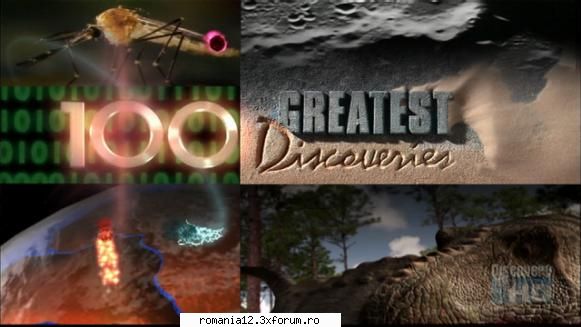romania12.3xforum.ro
Un forum pentru toti romanii de pretutindeni!
Aveti obligatia de a sterge in maxim 24 de ore orice fisier descarcat de pe acest forum. In caz contrar, administratorul si moderatorii nu-si asuma nici o raspundere.
|
Lista Forumurilor Pe Tematici
|
romania12.3xforum.ro | Reguli | Inregistrare | Login
POZE ROMANIA12.3XFORUM.RO
Nu sunteti logat.
|
Nou pe simpatie:
Ana Maria 25 pe Simpatie.ro
 | Femeie
24 ani
Bucuresti
cauta Barbat
35 - 68 ani |
|
mario_75
Administrator
 Inregistrat: acum 18 ani
|
|
Info despre film.
1. The Law of Falling Bodies (1604)
Galileo Galilei overturns nearly 2,000 years of Aristotelian belief that heavier bodies fall faster than lighter ones by proving that all bodies fall at the same rate.
2. Universal Gravitation (1666)
Isaac Newton comes to the conclusion that all objects in the universe, from apples to planets, exert gravitational attraction on each other.
3. Laws of Motion (1687)
Isaac Newton changes our understanding of the universe by formulating three laws to describe the movement of objects. 1) An object in motion remains in motion unless an external force is applied to it. 2) The relationship between an object's mass (m), its acceleration (a) and the applied force (F) is F = ma. 3) For every action there is an equal and opposite reaction.
4. The Second Law of Thermodynamics (1824 – 1850)
Scientists working to improve the efficiency of steam engines develop an understanding of the conversion of heat into work. They learn that the flow of heat from higher to lower temperatures is what drives a steam engine, likening the process to the flow of water that turns a mill wheel. Their work leads to three principles: heat flows spontaneously from a hot to a cold body; heat cannot be completely converted into other forms of energy; and systems become more disorganized over time.
5. Electromagnetism (1807 – 1873)
Pioneering experiments uncover the relationship between electricity and magnetism and lead to a set of equations that express the basic laws governing them. One of those experiments unexpectedly yields results in a classroom. In 1820, Danish physicist Hans Christian Oersted is speaking to students about the possibility that electricity and magnetism are related. During the lecture, an experiment demonstrates the veracity of his theory in front of the whole class.
6. Special Relativity (1905)
Albert Einstein overthrows basic assumptions about time and space by describing how clocks tick slower and distances appear to stretch as objects approach the speed of light.
7. E = mc^2 (1905)
Or energy is equal to mass times the speed of light squared. Albert Einstein's famous formula proves that mass and energy are different manifestations of the same thing, and that a very small amount of mass can be converted into a very large amount of energy. One profound implication of his discovery is that no object with mass can ever go faster than the speed of light.
8. The Quantum Leap (1900 – 1935)
To describe the behavior of subatomic particles, a new set of natural laws is developed by Max Planck, Albert Einstein, Werner Heisenberg and Erwin Schrodinger. A quantum leap is defined as the change of an electron within an atom from one energy state to another. This change happens all at once, not gradually.
9. The Nature of Light (1704 – 1905)
Thought and experimentation by Isaac Newton, Thomas Young and Albert Einstein lead to an understanding of what light is, how it behaves, and how it is transmitted. Newton uses a prism to split white light into its constituent colors and another prism to mix the colors into white light, proving that colored light mixed together makes white light. Young establishes that light is a wave and that wavelength determines color. Finally, Einstein recognizes that light always travels at a constant speed, no matter the speed of the measurer.
10. The Neutron (1935)
James Chadwick discovers neutrons, which, together with protons and electrons comprise the atom. This finding dramatically changes the atomic model and accelerates discoveries in atomic physics.
11. Superconductors (1911 – 1986)
The unexpected discovery that some materials have no resistance to the flow of electricity promises to revolutionize industry and technology. Superconductivity occurs in a wide variety of materials, including simple elements like tin and aluminum, various metallic alloys and certain ceramic compounds.
12. Quarks (1962)
Murray Gell-Mann proposes the existence of fundamental particles that combine to form composite objects such as protons and neutrons. A quark has both an electric and a "strong" charge. Protons and neutrons each contain three quarks.
13. Nuclear Forces (1666 – 1957)
Discoveries of the basic forces at work on the subatomic level lead to the realization that all interactions in the universe are the result of four fundamental forces of nature — the strong and weak nuclear forces, the electromagnetic force and gravitation.
Links RS:
Marime: 715 MB.
Pass pt accesarea link-urilor si pt dezarhivare:
34.4KB
_______________________________________
Failure is not the end of the world. It's an opportunity to improve on your last attempt.
Buy a Hotfile premium acount here
|
|
| pus acum 18 ani |
|

